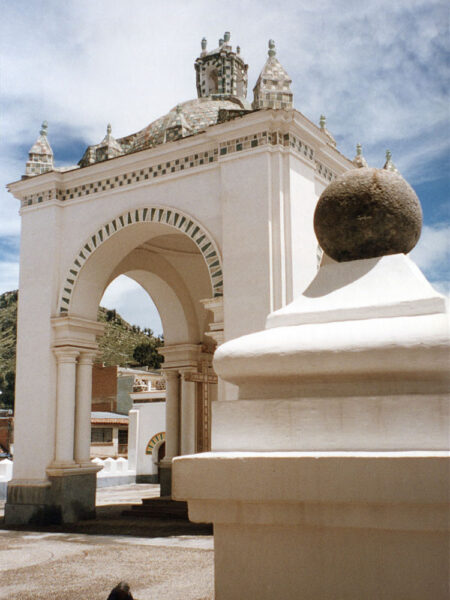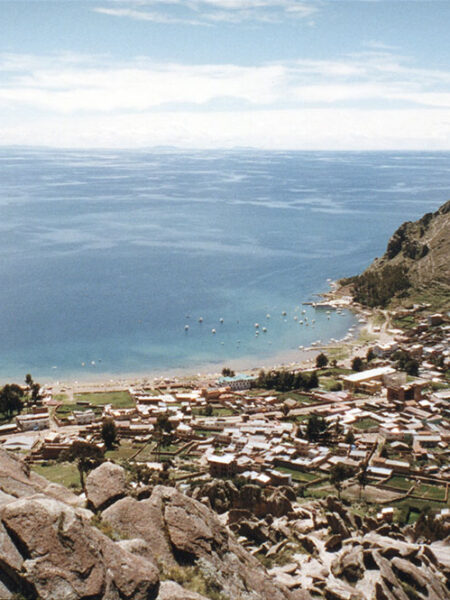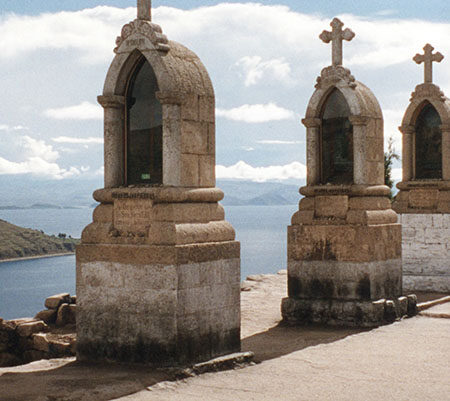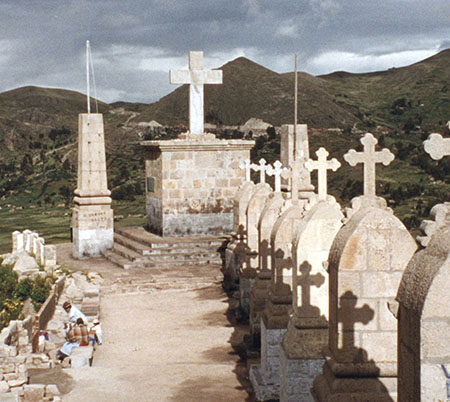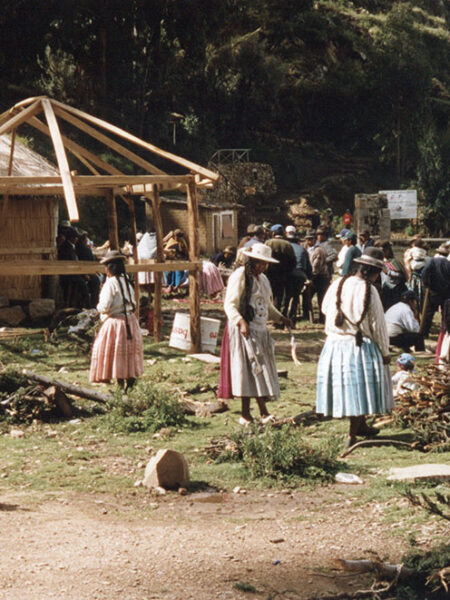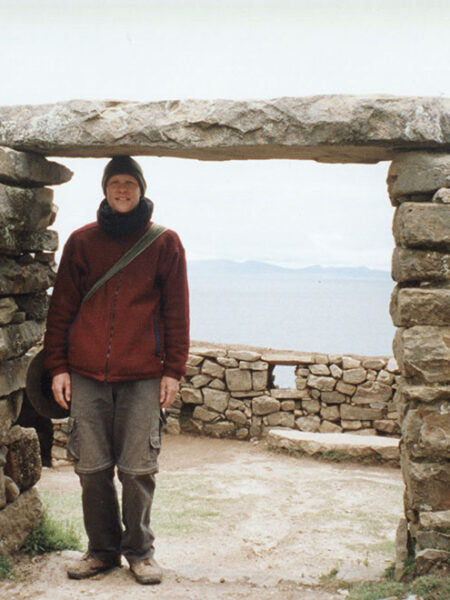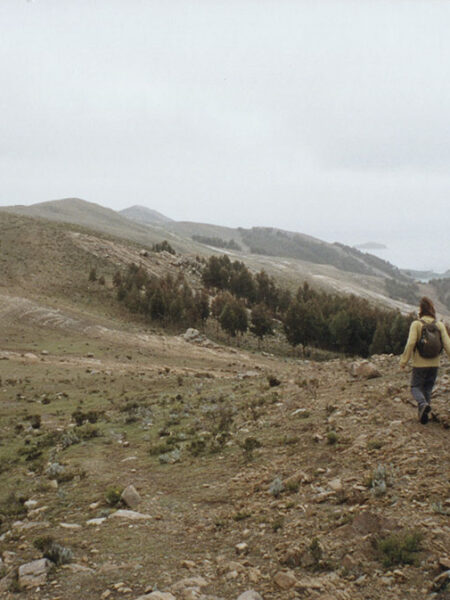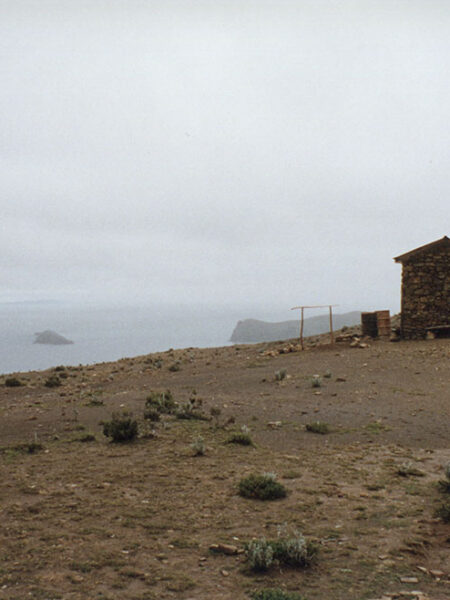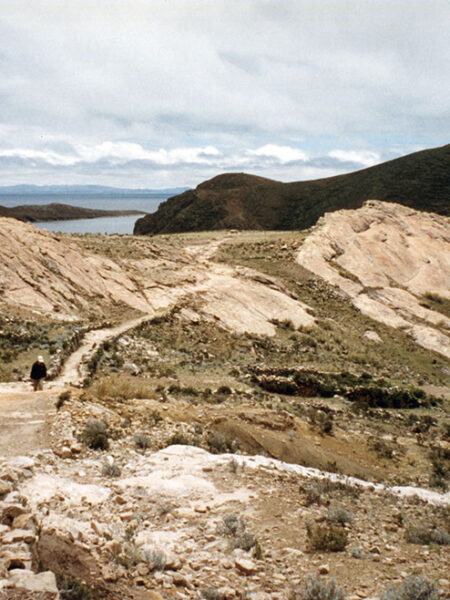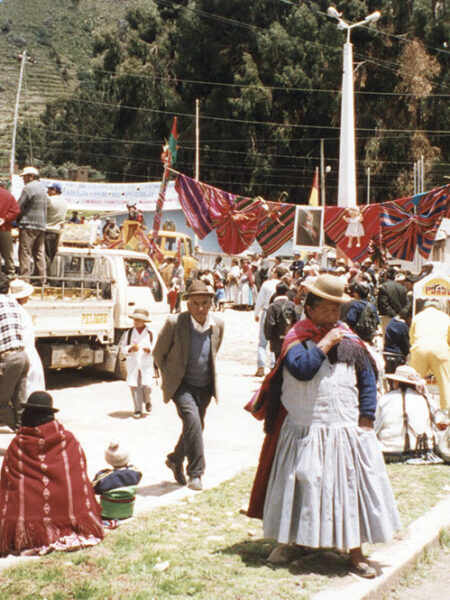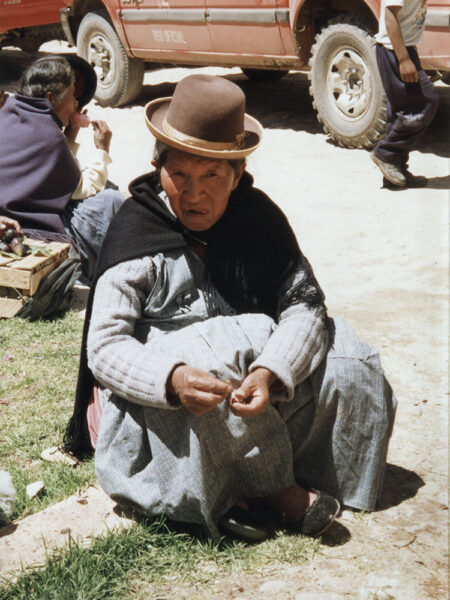In the morning L and I decided to head for Copacabana, our trekking days over for the moment. A midday bus to Huarina, and from there we grabbed a passing bus to Copacabana. Halfway there, the bus broke down and we all climbed out, and I got talking to a couple of Germans.
At the Estrecho de Tiquina (Strait of Tiquina) we left the bus and were given life jackets for a quick trip across the water to the other side to rejoin our bus. Lake Titicaca is huge and spectacular, and the drive to Copacabana, a beautiful gem of a town on the shore resting between two tall hills, was beautiful.
L, the Germans, and I got a room at the Hostal La Cúpula, one of the most comfortable hotels of my trip. A neat garden has a view of the lake and the town, and at the resturant we had dinner and wine.
The next day, when the morning’s bad weather had cleared, we checked out the town’s Moorish cathedral – a very mosque-like building with a huge courtyard, sparkling white in the sunshine. I watched people bow heads and knees before a gaudy doll of Mary and wondered again at why they devote their lives to this strange Catholic superstition and idol worship.
After lunch we separated and went for walks. I headed up to La Horca del Inca, a hill of strange rock formations that features an Inca ‘observatory’ – a rock plinth crossing two rock towers, still used to predict the year’s harvest by Aymara priests in the town. At the top of the hill was a beautiful view over Copacabana and the lake.
Back down, through town and up the other hill/headland, where fourteen stations of the Cross has transformed it into a pilgrimage site. A long, steep climb up rock steps to a series of shrines surmounted by crosses, where Bolivians burnt candles and bought toy cars or house or dollar bills in the hope of receiving the real thing. A strange mix of Catholicism and native custom. Sitting on the highest point I looked out over the lake, more of a sea it seemed, stretching flat and far to the horizon – almost 4 kilometres above the level of the real sea.
That evening we all had our last dinner together in a smoky little restaurant with painted adobe walls. I had a delicious stuffed trout and we quaffed a few bottles of red.
The next day we were going our separate ways. L got up early to go to Isla del Sol on the lake, and the Germans later headed for Cuzco. Early afternoon I left my gear at the hotel, and with a shoulder bag walked alone to the shore and caught the slow boat to Isla del Sol; on the trip I slipped into a daze in the heat and the steady thrumming of the engine and snatches of foreign languages. The rippling surface of the lake met the clouds with hardly a line between them. The island was the birthplace of the sun according to the Incas, and at that altitude, with the sun powerful in the thin air, it’s easy to see why. In about one and a half hours the boat arrived at the Escalera del Inca, the Inca Stairway, where springwater gushes down a hillside flanked by Inca steps. The locals were chopping down a huge tree and travellers milled about the beach waiting for the next boat. I headed up the hill and found a room for the night at a new little hotel (so new the toilets didn’t flush yet!) in the village of Yumani.
I walked to the south end of the island along a high hillside track, enjoying the isolation and the lack of roads and modern civilisation, to the Pilko Kaina ruins, an Inca building by the shore. A cold, sweaty walk back to the village, and up to the ridgeline for a beautiful view of the lake, the shore of Peru in the distance. A meal of trout, chips, rice, soup, beer and mato de coca tea. Outside the hotel, standing in the dark, I listened to a man walk up the path playing pan pipes. The island is dark and quiet, and it’s easy to imagine what village life was like before the modern world closed in.
The next day I met a French Swiss guy and a German girl, and we decided to walk along the ridgeline to the north of the island together. A spectacular, really enjoyable hike with beautiful views of the island to either side, good company and the endless flat blue of Lake Titicaca to the horizon. After about a three hour walk we reached the Chincana ruins at the north end, a little labyrinth of stone walls. Nearby, the Rock of the Puma which featured in the Inca creation legend. Walked through a little village, past villagers cutting up a slaughtered cow in a field, to the lakeside village of Cha’llapampa, where with a Brazilian couple we met, we chartered a little boat for a 45 minute putter back to the Stairway.
I said farewell to my walking companions and got the boat back to Copacabana, a long hot trip on the top deck, chatting to the Brazilians and dozing under my wide brimmed hat and several layers of sunscreen. Back at La Cúpula I met a couple of English girls as I was reading in the garden, and we had an excellent meal and a couple of bottles of red in a restaurant in town.
Next morning it was time to get moving, to cross over into Peru. The bus was delayed by a colourful official ceremony (inaugurating some new road project) complete with banners, grandiose portraits, and lots of locals sitting around enjoying the sun and festivities. Pompous looking officials resplendent in their badges of office took turns to make speeches. Good opportunity to take photos of the interesting locals though.
I was lucky, as there was a guided tour group on my bus, so I followed them through the chaos of the Bolivian and Peruvian border posts and got through quickly and easily. After changing buses on the Peruvian side the next stop was a long bridge that had been damaged by flood, so we all disembarked and with many others walked across to meet the bus on the other side. My first real glimpse of Peru and it seems to be much more like India – more crowded and chaotic than Bolivia, with ugly concrete and brick shacks with steel reinforcing rods sticking up out of them.
Forced to listen to loud, distorted and annoying music over the bus speakers, I travelled to Puno.


